Nursing Practice: Examining Legal Standards of Care and Implications
VerifiedAdded on 2023/04/21
|12
|3051
|414
Essay
AI Summary
This essay delves into the legal standards of care for nurses, highlighting their importance in nursing practice. It discusses the evolution of nursing standards, the concept of malpractice, and the legal protections afforded to nursing professionals. The paper examines the legal context of nursing standards, including the roles of advanced nurse practitioners and areas where malpractice commonly occurs. Key components of malpractice are outlined, and practical measures to mitigate legal risks are recommended. Furthermore, the essay provides an overview of federal and state regulations that impact nursing practice, such as the Privacy Act, HIPAA, the Health Care Quality Improvement Act, and the Patient Self-Determination Act, emphasizing the importance of nurses' awareness of these legal considerations and the implications of social networking in healthcare.
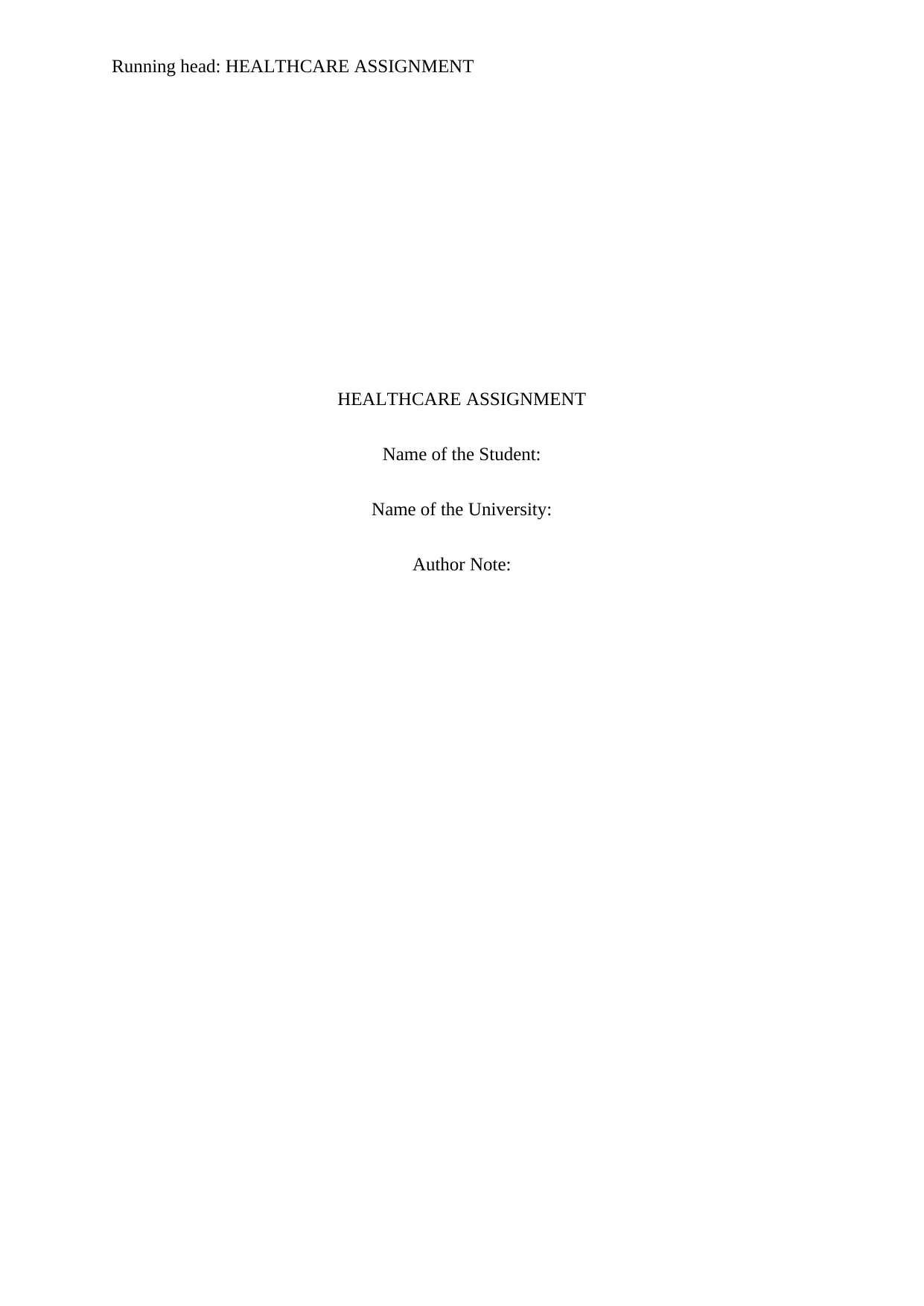
Running head: HEALTHCARE ASSIGNMENT
HEALTHCARE ASSIGNMENT
Name of the Student:
Name of the University:
Author Note:
HEALTHCARE ASSIGNMENT
Name of the Student:
Name of the University:
Author Note:
Paraphrase This Document
Need a fresh take? Get an instant paraphrase of this document with our AI Paraphraser
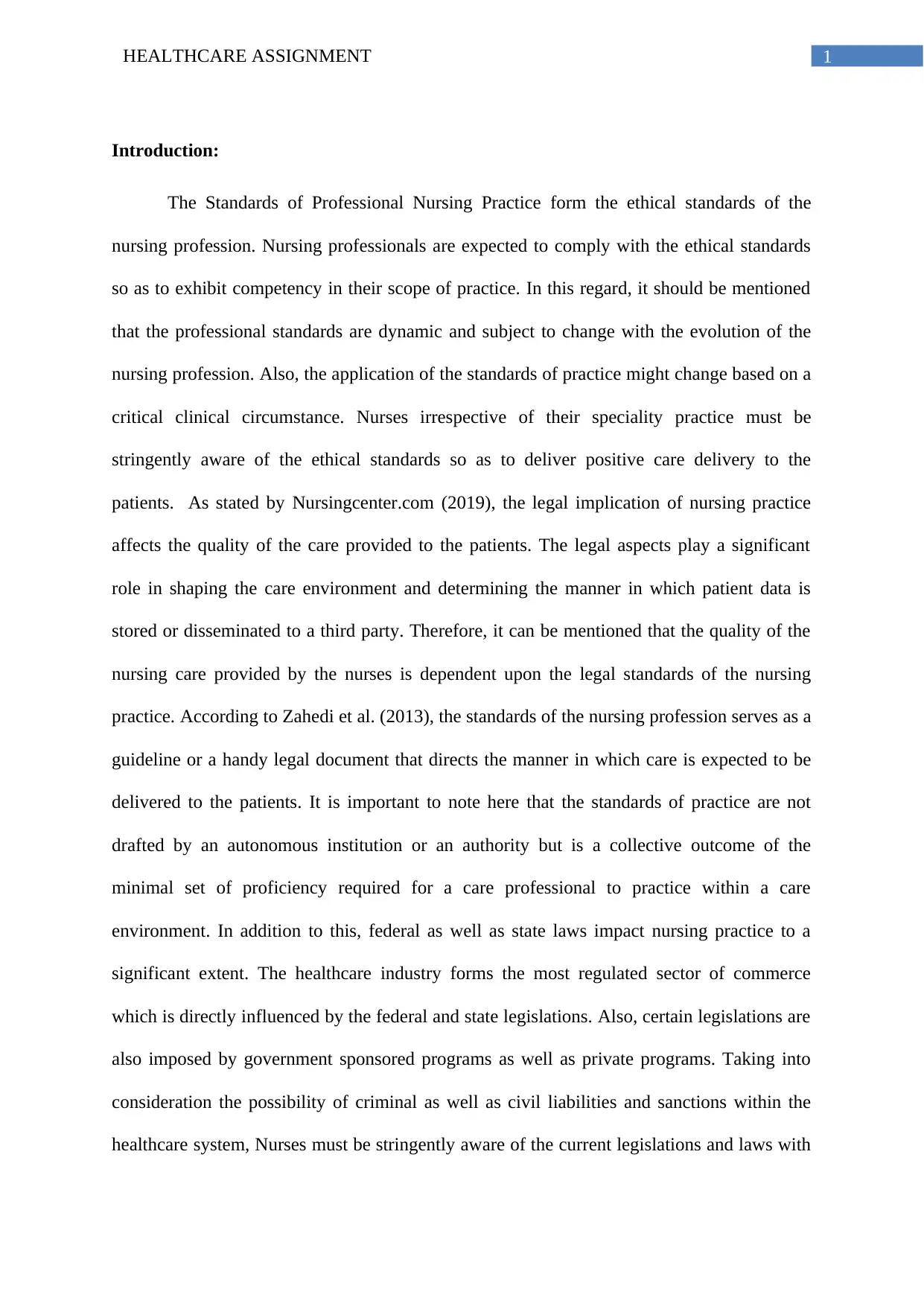
1HEALTHCARE ASSIGNMENT
Introduction:
The Standards of Professional Nursing Practice form the ethical standards of the
nursing profession. Nursing professionals are expected to comply with the ethical standards
so as to exhibit competency in their scope of practice. In this regard, it should be mentioned
that the professional standards are dynamic and subject to change with the evolution of the
nursing profession. Also, the application of the standards of practice might change based on a
critical clinical circumstance. Nurses irrespective of their speciality practice must be
stringently aware of the ethical standards so as to deliver positive care delivery to the
patients. As stated by Nursingcenter.com (2019), the legal implication of nursing practice
affects the quality of the care provided to the patients. The legal aspects play a significant
role in shaping the care environment and determining the manner in which patient data is
stored or disseminated to a third party. Therefore, it can be mentioned that the quality of the
nursing care provided by the nurses is dependent upon the legal standards of the nursing
practice. According to Zahedi et al. (2013), the standards of the nursing profession serves as a
guideline or a handy legal document that directs the manner in which care is expected to be
delivered to the patients. It is important to note here that the standards of practice are not
drafted by an autonomous institution or an authority but is a collective outcome of the
minimal set of proficiency required for a care professional to practice within a care
environment. In addition to this, federal as well as state laws impact nursing practice to a
significant extent. The healthcare industry forms the most regulated sector of commerce
which is directly influenced by the federal and state legislations. Also, certain legislations are
also imposed by government sponsored programs as well as private programs. Taking into
consideration the possibility of criminal as well as civil liabilities and sanctions within the
healthcare system, Nurses must be stringently aware of the current legislations and laws with
Introduction:
The Standards of Professional Nursing Practice form the ethical standards of the
nursing profession. Nursing professionals are expected to comply with the ethical standards
so as to exhibit competency in their scope of practice. In this regard, it should be mentioned
that the professional standards are dynamic and subject to change with the evolution of the
nursing profession. Also, the application of the standards of practice might change based on a
critical clinical circumstance. Nurses irrespective of their speciality practice must be
stringently aware of the ethical standards so as to deliver positive care delivery to the
patients. As stated by Nursingcenter.com (2019), the legal implication of nursing practice
affects the quality of the care provided to the patients. The legal aspects play a significant
role in shaping the care environment and determining the manner in which patient data is
stored or disseminated to a third party. Therefore, it can be mentioned that the quality of the
nursing care provided by the nurses is dependent upon the legal standards of the nursing
practice. According to Zahedi et al. (2013), the standards of the nursing profession serves as a
guideline or a handy legal document that directs the manner in which care is expected to be
delivered to the patients. It is important to note here that the standards of practice are not
drafted by an autonomous institution or an authority but is a collective outcome of the
minimal set of proficiency required for a care professional to practice within a care
environment. In addition to this, federal as well as state laws impact nursing practice to a
significant extent. The healthcare industry forms the most regulated sector of commerce
which is directly influenced by the federal and state legislations. Also, certain legislations are
also imposed by government sponsored programs as well as private programs. Taking into
consideration the possibility of criminal as well as civil liabilities and sanctions within the
healthcare system, Nurses must be stringently aware of the current legislations and laws with
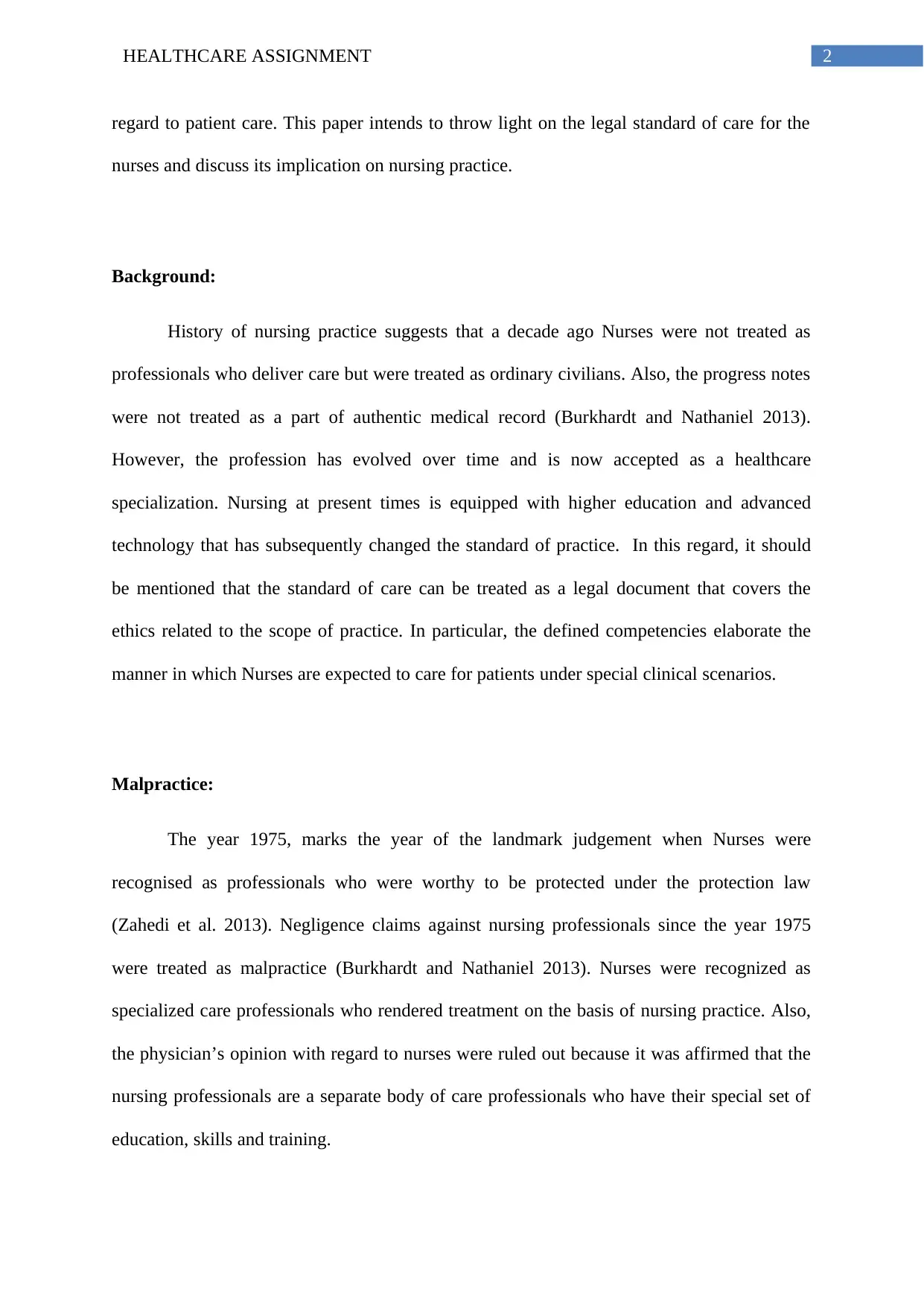
2HEALTHCARE ASSIGNMENT
regard to patient care. This paper intends to throw light on the legal standard of care for the
nurses and discuss its implication on nursing practice.
Background:
History of nursing practice suggests that a decade ago Nurses were not treated as
professionals who deliver care but were treated as ordinary civilians. Also, the progress notes
were not treated as a part of authentic medical record (Burkhardt and Nathaniel 2013).
However, the profession has evolved over time and is now accepted as a healthcare
specialization. Nursing at present times is equipped with higher education and advanced
technology that has subsequently changed the standard of practice. In this regard, it should
be mentioned that the standard of care can be treated as a legal document that covers the
ethics related to the scope of practice. In particular, the defined competencies elaborate the
manner in which Nurses are expected to care for patients under special clinical scenarios.
Malpractice:
The year 1975, marks the year of the landmark judgement when Nurses were
recognised as professionals who were worthy to be protected under the protection law
(Zahedi et al. 2013). Negligence claims against nursing professionals since the year 1975
were treated as malpractice (Burkhardt and Nathaniel 2013). Nurses were recognized as
specialized care professionals who rendered treatment on the basis of nursing practice. Also,
the physician’s opinion with regard to nurses were ruled out because it was affirmed that the
nursing professionals are a separate body of care professionals who have their special set of
education, skills and training.
regard to patient care. This paper intends to throw light on the legal standard of care for the
nurses and discuss its implication on nursing practice.
Background:
History of nursing practice suggests that a decade ago Nurses were not treated as
professionals who deliver care but were treated as ordinary civilians. Also, the progress notes
were not treated as a part of authentic medical record (Burkhardt and Nathaniel 2013).
However, the profession has evolved over time and is now accepted as a healthcare
specialization. Nursing at present times is equipped with higher education and advanced
technology that has subsequently changed the standard of practice. In this regard, it should
be mentioned that the standard of care can be treated as a legal document that covers the
ethics related to the scope of practice. In particular, the defined competencies elaborate the
manner in which Nurses are expected to care for patients under special clinical scenarios.
Malpractice:
The year 1975, marks the year of the landmark judgement when Nurses were
recognised as professionals who were worthy to be protected under the protection law
(Zahedi et al. 2013). Negligence claims against nursing professionals since the year 1975
were treated as malpractice (Burkhardt and Nathaniel 2013). Nurses were recognized as
specialized care professionals who rendered treatment on the basis of nursing practice. Also,
the physician’s opinion with regard to nurses were ruled out because it was affirmed that the
nursing professionals are a separate body of care professionals who have their special set of
education, skills and training.
⊘ This is a preview!⊘
Do you want full access?
Subscribe today to unlock all pages.

Trusted by 1+ million students worldwide
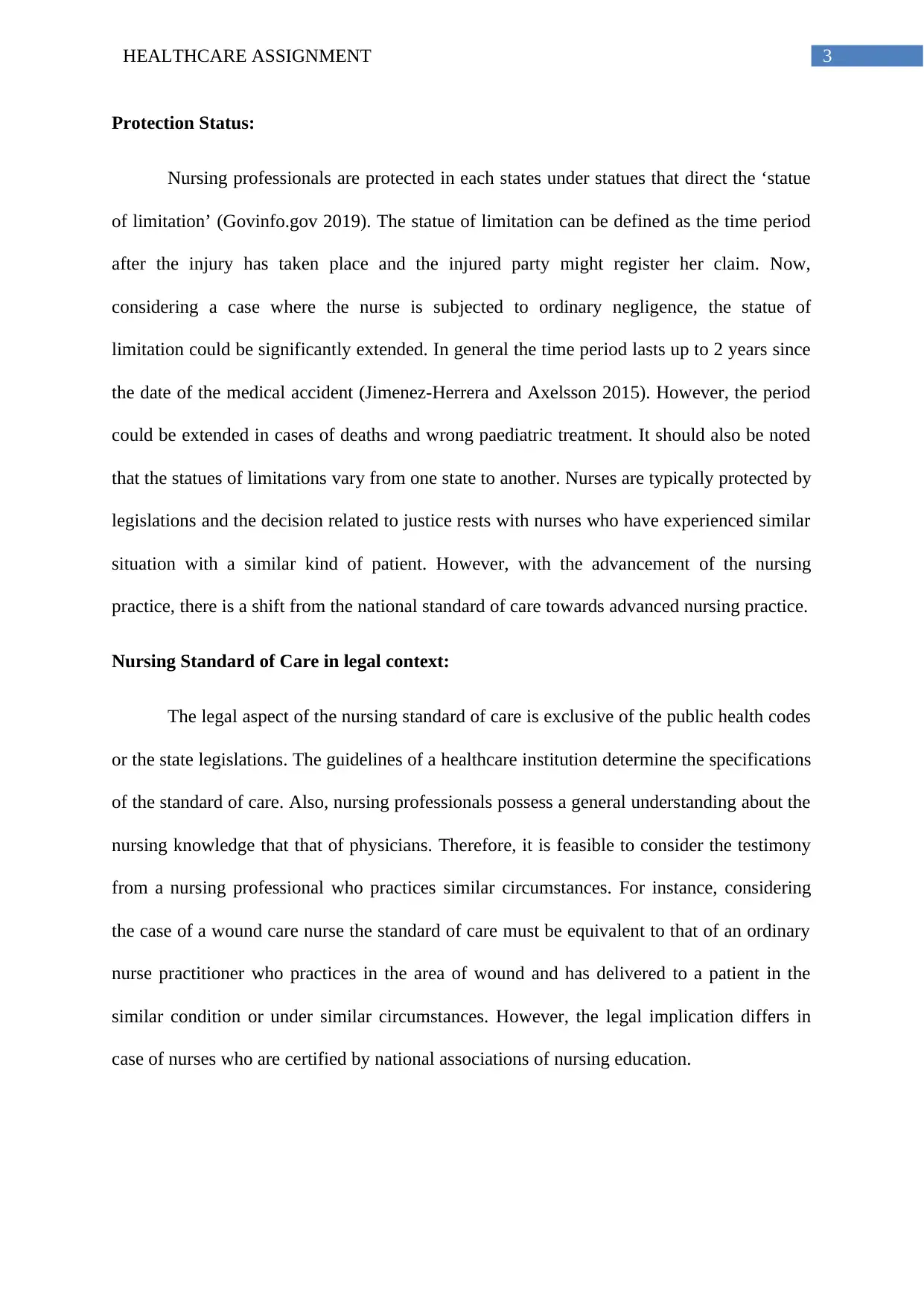
3HEALTHCARE ASSIGNMENT
Protection Status:
Nursing professionals are protected in each states under statues that direct the ‘statue
of limitation’ (Govinfo.gov 2019). The statue of limitation can be defined as the time period
after the injury has taken place and the injured party might register her claim. Now,
considering a case where the nurse is subjected to ordinary negligence, the statue of
limitation could be significantly extended. In general the time period lasts up to 2 years since
the date of the medical accident (Jimenez-Herrera and Axelsson 2015). However, the period
could be extended in cases of deaths and wrong paediatric treatment. It should also be noted
that the statues of limitations vary from one state to another. Nurses are typically protected by
legislations and the decision related to justice rests with nurses who have experienced similar
situation with a similar kind of patient. However, with the advancement of the nursing
practice, there is a shift from the national standard of care towards advanced nursing practice.
Nursing Standard of Care in legal context:
The legal aspect of the nursing standard of care is exclusive of the public health codes
or the state legislations. The guidelines of a healthcare institution determine the specifications
of the standard of care. Also, nursing professionals possess a general understanding about the
nursing knowledge that that of physicians. Therefore, it is feasible to consider the testimony
from a nursing professional who practices similar circumstances. For instance, considering
the case of a wound care nurse the standard of care must be equivalent to that of an ordinary
nurse practitioner who practices in the area of wound and has delivered to a patient in the
similar condition or under similar circumstances. However, the legal implication differs in
case of nurses who are certified by national associations of nursing education.
Protection Status:
Nursing professionals are protected in each states under statues that direct the ‘statue
of limitation’ (Govinfo.gov 2019). The statue of limitation can be defined as the time period
after the injury has taken place and the injured party might register her claim. Now,
considering a case where the nurse is subjected to ordinary negligence, the statue of
limitation could be significantly extended. In general the time period lasts up to 2 years since
the date of the medical accident (Jimenez-Herrera and Axelsson 2015). However, the period
could be extended in cases of deaths and wrong paediatric treatment. It should also be noted
that the statues of limitations vary from one state to another. Nurses are typically protected by
legislations and the decision related to justice rests with nurses who have experienced similar
situation with a similar kind of patient. However, with the advancement of the nursing
practice, there is a shift from the national standard of care towards advanced nursing practice.
Nursing Standard of Care in legal context:
The legal aspect of the nursing standard of care is exclusive of the public health codes
or the state legislations. The guidelines of a healthcare institution determine the specifications
of the standard of care. Also, nursing professionals possess a general understanding about the
nursing knowledge that that of physicians. Therefore, it is feasible to consider the testimony
from a nursing professional who practices similar circumstances. For instance, considering
the case of a wound care nurse the standard of care must be equivalent to that of an ordinary
nurse practitioner who practices in the area of wound and has delivered to a patient in the
similar condition or under similar circumstances. However, the legal implication differs in
case of nurses who are certified by national associations of nursing education.
Paraphrase This Document
Need a fresh take? Get an instant paraphrase of this document with our AI Paraphraser
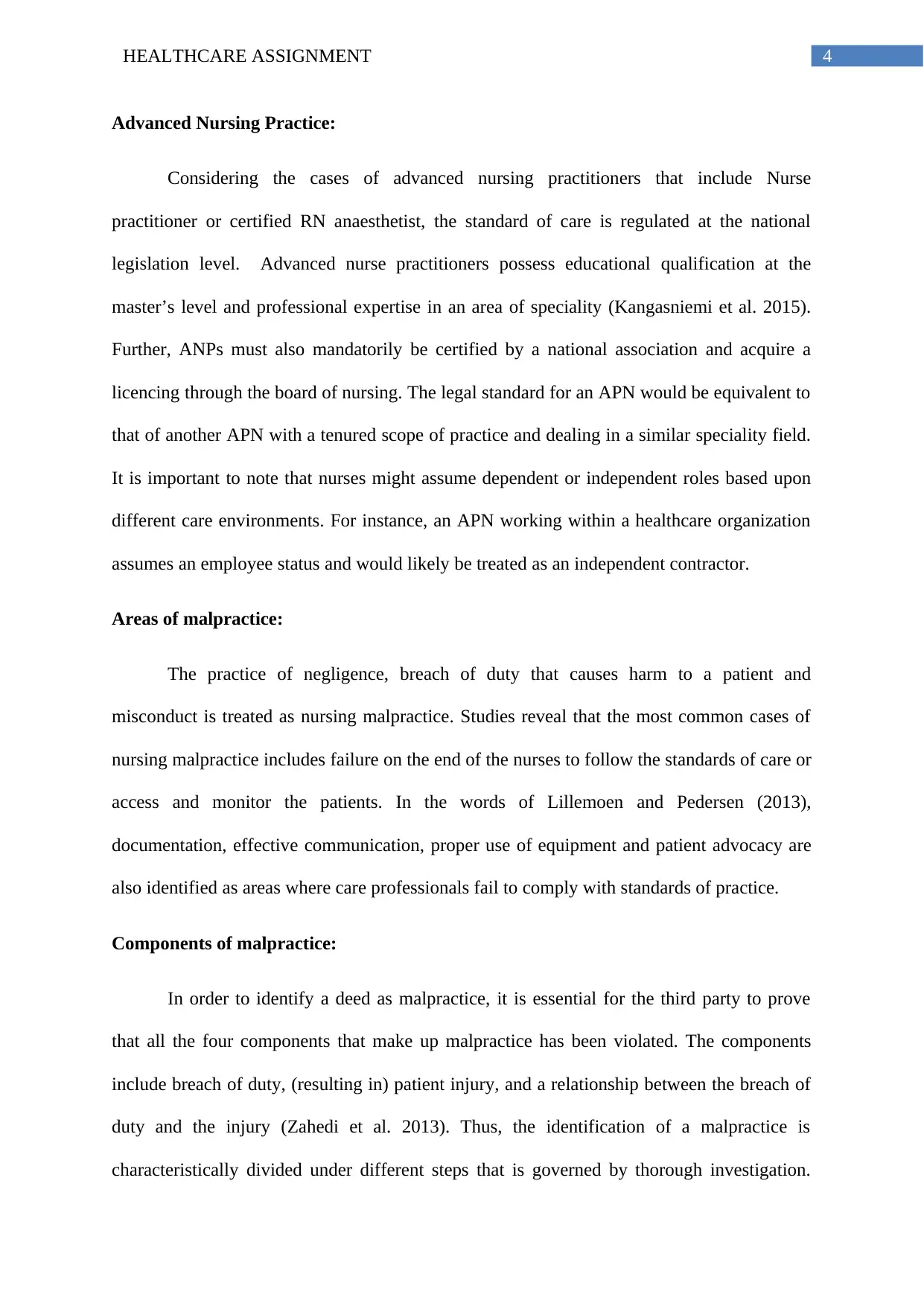
4HEALTHCARE ASSIGNMENT
Advanced Nursing Practice:
Considering the cases of advanced nursing practitioners that include Nurse
practitioner or certified RN anaesthetist, the standard of care is regulated at the national
legislation level. Advanced nurse practitioners possess educational qualification at the
master’s level and professional expertise in an area of speciality (Kangasniemi et al. 2015).
Further, ANPs must also mandatorily be certified by a national association and acquire a
licencing through the board of nursing. The legal standard for an APN would be equivalent to
that of another APN with a tenured scope of practice and dealing in a similar speciality field.
It is important to note that nurses might assume dependent or independent roles based upon
different care environments. For instance, an APN working within a healthcare organization
assumes an employee status and would likely be treated as an independent contractor.
Areas of malpractice:
The practice of negligence, breach of duty that causes harm to a patient and
misconduct is treated as nursing malpractice. Studies reveal that the most common cases of
nursing malpractice includes failure on the end of the nurses to follow the standards of care or
access and monitor the patients. In the words of Lillemoen and Pedersen (2013),
documentation, effective communication, proper use of equipment and patient advocacy are
also identified as areas where care professionals fail to comply with standards of practice.
Components of malpractice:
In order to identify a deed as malpractice, it is essential for the third party to prove
that all the four components that make up malpractice has been violated. The components
include breach of duty, (resulting in) patient injury, and a relationship between the breach of
duty and the injury (Zahedi et al. 2013). Thus, the identification of a malpractice is
characteristically divided under different steps that is governed by thorough investigation.
Advanced Nursing Practice:
Considering the cases of advanced nursing practitioners that include Nurse
practitioner or certified RN anaesthetist, the standard of care is regulated at the national
legislation level. Advanced nurse practitioners possess educational qualification at the
master’s level and professional expertise in an area of speciality (Kangasniemi et al. 2015).
Further, ANPs must also mandatorily be certified by a national association and acquire a
licencing through the board of nursing. The legal standard for an APN would be equivalent to
that of another APN with a tenured scope of practice and dealing in a similar speciality field.
It is important to note that nurses might assume dependent or independent roles based upon
different care environments. For instance, an APN working within a healthcare organization
assumes an employee status and would likely be treated as an independent contractor.
Areas of malpractice:
The practice of negligence, breach of duty that causes harm to a patient and
misconduct is treated as nursing malpractice. Studies reveal that the most common cases of
nursing malpractice includes failure on the end of the nurses to follow the standards of care or
access and monitor the patients. In the words of Lillemoen and Pedersen (2013),
documentation, effective communication, proper use of equipment and patient advocacy are
also identified as areas where care professionals fail to comply with standards of practice.
Components of malpractice:
In order to identify a deed as malpractice, it is essential for the third party to prove
that all the four components that make up malpractice has been violated. The components
include breach of duty, (resulting in) patient injury, and a relationship between the breach of
duty and the injury (Zahedi et al. 2013). Thus, the identification of a malpractice is
characteristically divided under different steps that is governed by thorough investigation.
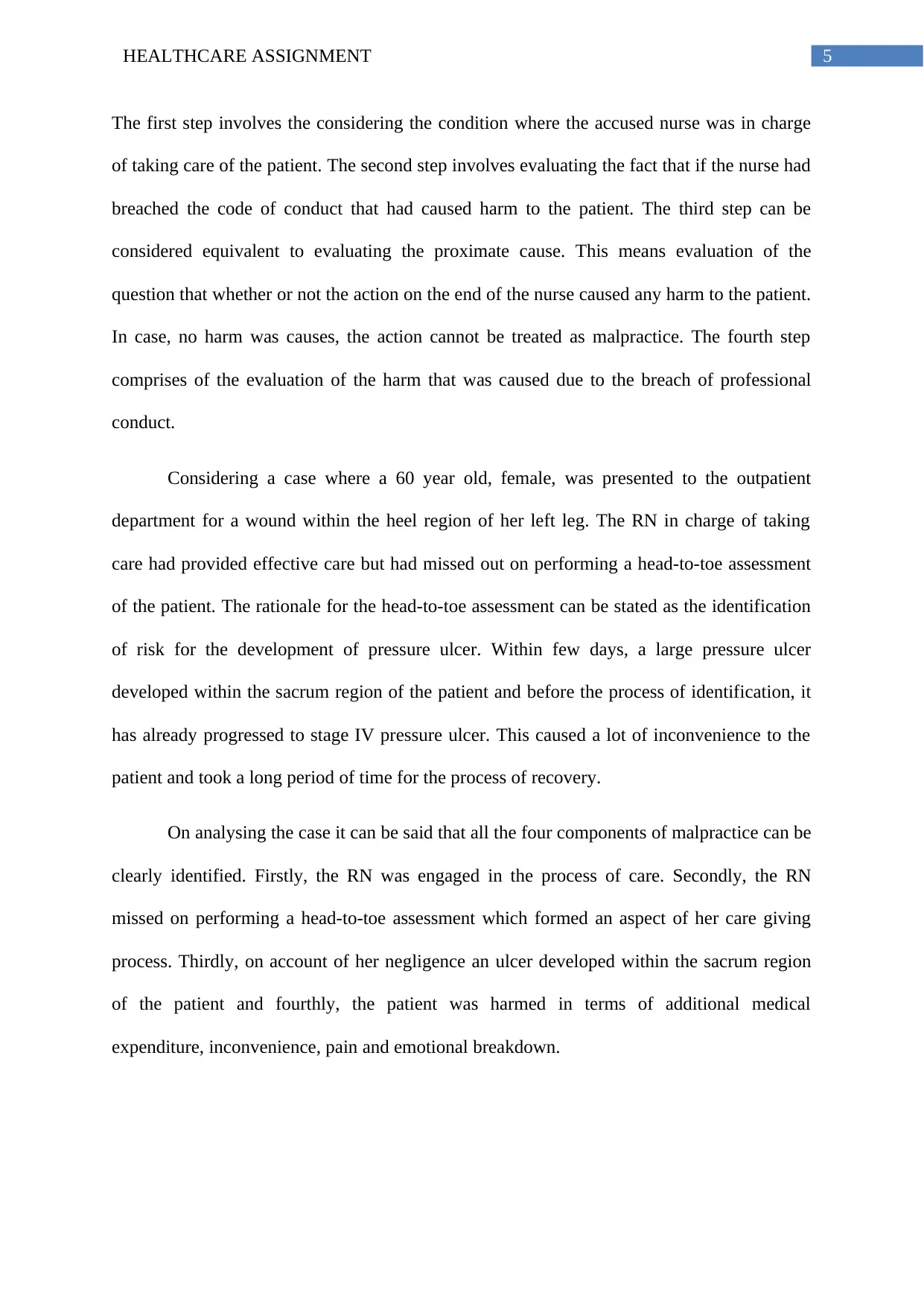
5HEALTHCARE ASSIGNMENT
The first step involves the considering the condition where the accused nurse was in charge
of taking care of the patient. The second step involves evaluating the fact that if the nurse had
breached the code of conduct that had caused harm to the patient. The third step can be
considered equivalent to evaluating the proximate cause. This means evaluation of the
question that whether or not the action on the end of the nurse caused any harm to the patient.
In case, no harm was causes, the action cannot be treated as malpractice. The fourth step
comprises of the evaluation of the harm that was caused due to the breach of professional
conduct.
Considering a case where a 60 year old, female, was presented to the outpatient
department for a wound within the heel region of her left leg. The RN in charge of taking
care had provided effective care but had missed out on performing a head-to-toe assessment
of the patient. The rationale for the head-to-toe assessment can be stated as the identification
of risk for the development of pressure ulcer. Within few days, a large pressure ulcer
developed within the sacrum region of the patient and before the process of identification, it
has already progressed to stage IV pressure ulcer. This caused a lot of inconvenience to the
patient and took a long period of time for the process of recovery.
On analysing the case it can be said that all the four components of malpractice can be
clearly identified. Firstly, the RN was engaged in the process of care. Secondly, the RN
missed on performing a head-to-toe assessment which formed an aspect of her care giving
process. Thirdly, on account of her negligence an ulcer developed within the sacrum region
of the patient and fourthly, the patient was harmed in terms of additional medical
expenditure, inconvenience, pain and emotional breakdown.
The first step involves the considering the condition where the accused nurse was in charge
of taking care of the patient. The second step involves evaluating the fact that if the nurse had
breached the code of conduct that had caused harm to the patient. The third step can be
considered equivalent to evaluating the proximate cause. This means evaluation of the
question that whether or not the action on the end of the nurse caused any harm to the patient.
In case, no harm was causes, the action cannot be treated as malpractice. The fourth step
comprises of the evaluation of the harm that was caused due to the breach of professional
conduct.
Considering a case where a 60 year old, female, was presented to the outpatient
department for a wound within the heel region of her left leg. The RN in charge of taking
care had provided effective care but had missed out on performing a head-to-toe assessment
of the patient. The rationale for the head-to-toe assessment can be stated as the identification
of risk for the development of pressure ulcer. Within few days, a large pressure ulcer
developed within the sacrum region of the patient and before the process of identification, it
has already progressed to stage IV pressure ulcer. This caused a lot of inconvenience to the
patient and took a long period of time for the process of recovery.
On analysing the case it can be said that all the four components of malpractice can be
clearly identified. Firstly, the RN was engaged in the process of care. Secondly, the RN
missed on performing a head-to-toe assessment which formed an aspect of her care giving
process. Thirdly, on account of her negligence an ulcer developed within the sacrum region
of the patient and fourthly, the patient was harmed in terms of additional medical
expenditure, inconvenience, pain and emotional breakdown.
⊘ This is a preview!⊘
Do you want full access?
Subscribe today to unlock all pages.

Trusted by 1+ million students worldwide
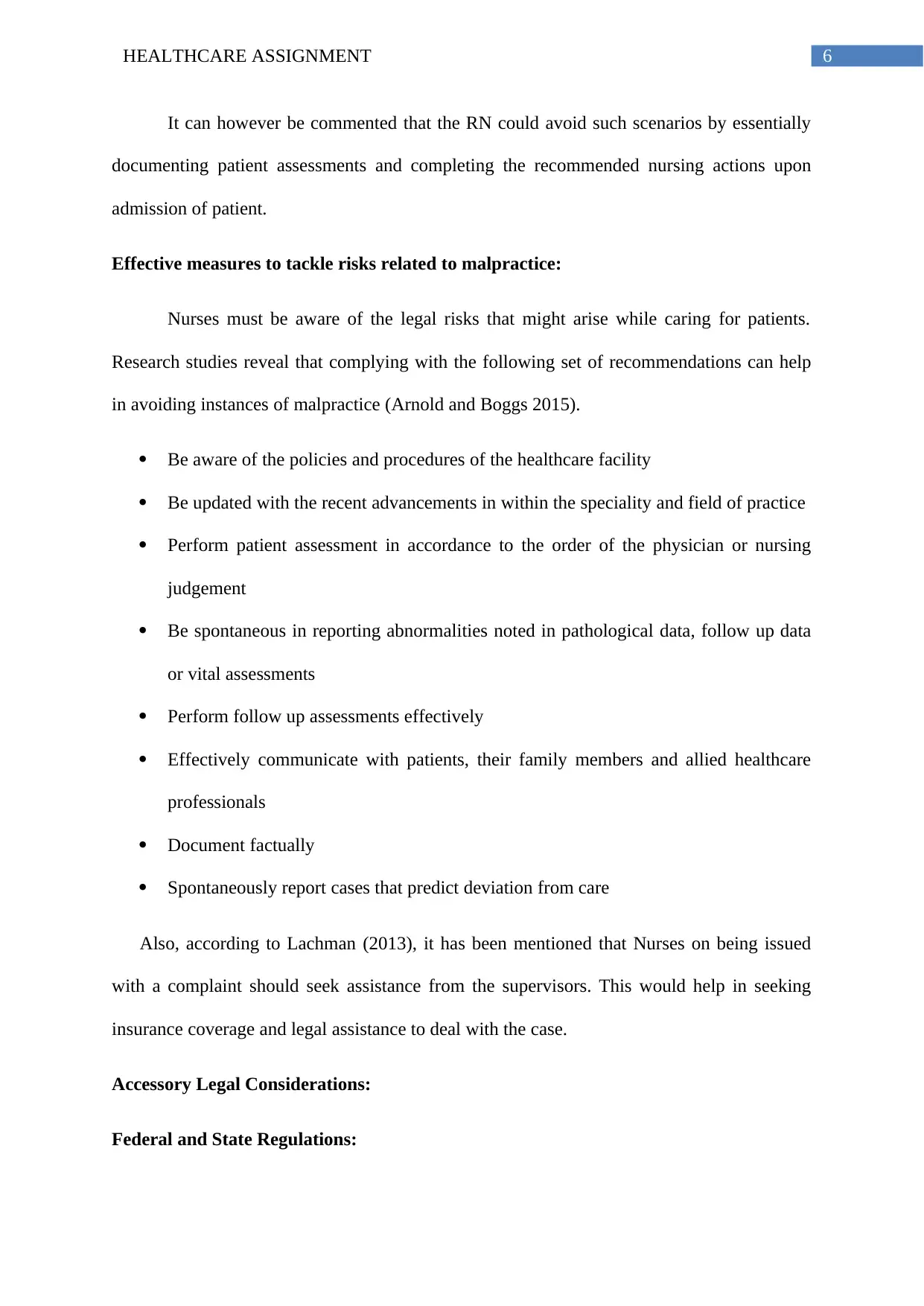
6HEALTHCARE ASSIGNMENT
It can however be commented that the RN could avoid such scenarios by essentially
documenting patient assessments and completing the recommended nursing actions upon
admission of patient.
Effective measures to tackle risks related to malpractice:
Nurses must be aware of the legal risks that might arise while caring for patients.
Research studies reveal that complying with the following set of recommendations can help
in avoiding instances of malpractice (Arnold and Boggs 2015).
Be aware of the policies and procedures of the healthcare facility
Be updated with the recent advancements in within the speciality and field of practice
Perform patient assessment in accordance to the order of the physician or nursing
judgement
Be spontaneous in reporting abnormalities noted in pathological data, follow up data
or vital assessments
Perform follow up assessments effectively
Effectively communicate with patients, their family members and allied healthcare
professionals
Document factually
Spontaneously report cases that predict deviation from care
Also, according to Lachman (2013), it has been mentioned that Nurses on being issued
with a complaint should seek assistance from the supervisors. This would help in seeking
insurance coverage and legal assistance to deal with the case.
Accessory Legal Considerations:
Federal and State Regulations:
It can however be commented that the RN could avoid such scenarios by essentially
documenting patient assessments and completing the recommended nursing actions upon
admission of patient.
Effective measures to tackle risks related to malpractice:
Nurses must be aware of the legal risks that might arise while caring for patients.
Research studies reveal that complying with the following set of recommendations can help
in avoiding instances of malpractice (Arnold and Boggs 2015).
Be aware of the policies and procedures of the healthcare facility
Be updated with the recent advancements in within the speciality and field of practice
Perform patient assessment in accordance to the order of the physician or nursing
judgement
Be spontaneous in reporting abnormalities noted in pathological data, follow up data
or vital assessments
Perform follow up assessments effectively
Effectively communicate with patients, their family members and allied healthcare
professionals
Document factually
Spontaneously report cases that predict deviation from care
Also, according to Lachman (2013), it has been mentioned that Nurses on being issued
with a complaint should seek assistance from the supervisors. This would help in seeking
insurance coverage and legal assistance to deal with the case.
Accessory Legal Considerations:
Federal and State Regulations:
Paraphrase This Document
Need a fresh take? Get an instant paraphrase of this document with our AI Paraphraser
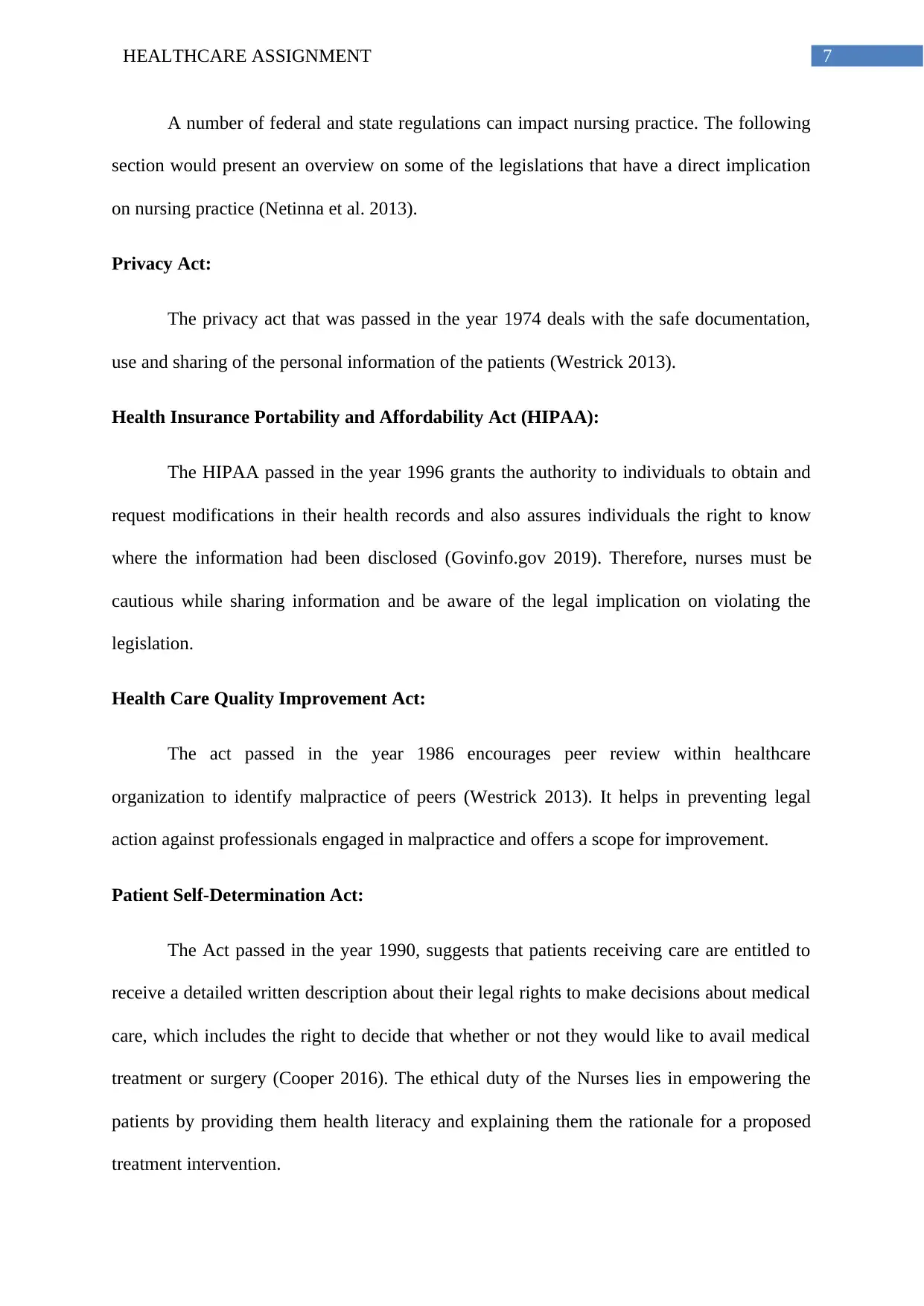
7HEALTHCARE ASSIGNMENT
A number of federal and state regulations can impact nursing practice. The following
section would present an overview on some of the legislations that have a direct implication
on nursing practice (Netinna et al. 2013).
Privacy Act:
The privacy act that was passed in the year 1974 deals with the safe documentation,
use and sharing of the personal information of the patients (Westrick 2013).
Health Insurance Portability and Affordability Act (HIPAA):
The HIPAA passed in the year 1996 grants the authority to individuals to obtain and
request modifications in their health records and also assures individuals the right to know
where the information had been disclosed (Govinfo.gov 2019). Therefore, nurses must be
cautious while sharing information and be aware of the legal implication on violating the
legislation.
Health Care Quality Improvement Act:
The act passed in the year 1986 encourages peer review within healthcare
organization to identify malpractice of peers (Westrick 2013). It helps in preventing legal
action against professionals engaged in malpractice and offers a scope for improvement.
Patient Self-Determination Act:
The Act passed in the year 1990, suggests that patients receiving care are entitled to
receive a detailed written description about their legal rights to make decisions about medical
care, which includes the right to decide that whether or not they would like to avail medical
treatment or surgery (Cooper 2016). The ethical duty of the Nurses lies in empowering the
patients by providing them health literacy and explaining them the rationale for a proposed
treatment intervention.
A number of federal and state regulations can impact nursing practice. The following
section would present an overview on some of the legislations that have a direct implication
on nursing practice (Netinna et al. 2013).
Privacy Act:
The privacy act that was passed in the year 1974 deals with the safe documentation,
use and sharing of the personal information of the patients (Westrick 2013).
Health Insurance Portability and Affordability Act (HIPAA):
The HIPAA passed in the year 1996 grants the authority to individuals to obtain and
request modifications in their health records and also assures individuals the right to know
where the information had been disclosed (Govinfo.gov 2019). Therefore, nurses must be
cautious while sharing information and be aware of the legal implication on violating the
legislation.
Health Care Quality Improvement Act:
The act passed in the year 1986 encourages peer review within healthcare
organization to identify malpractice of peers (Westrick 2013). It helps in preventing legal
action against professionals engaged in malpractice and offers a scope for improvement.
Patient Self-Determination Act:
The Act passed in the year 1990, suggests that patients receiving care are entitled to
receive a detailed written description about their legal rights to make decisions about medical
care, which includes the right to decide that whether or not they would like to avail medical
treatment or surgery (Cooper 2016). The ethical duty of the Nurses lies in empowering the
patients by providing them health literacy and explaining them the rationale for a proposed
treatment intervention.
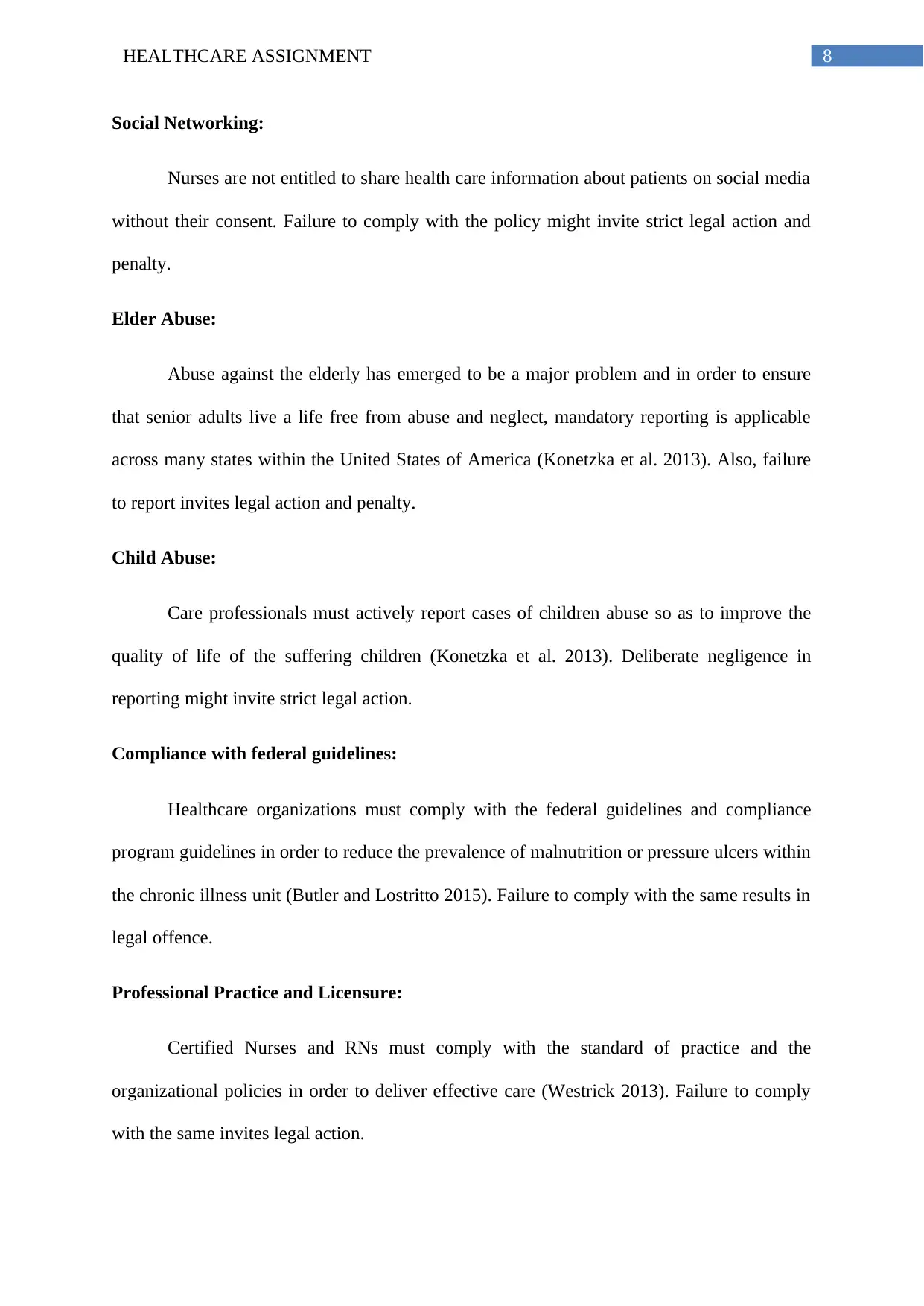
8HEALTHCARE ASSIGNMENT
Social Networking:
Nurses are not entitled to share health care information about patients on social media
without their consent. Failure to comply with the policy might invite strict legal action and
penalty.
Elder Abuse:
Abuse against the elderly has emerged to be a major problem and in order to ensure
that senior adults live a life free from abuse and neglect, mandatory reporting is applicable
across many states within the United States of America (Konetzka et al. 2013). Also, failure
to report invites legal action and penalty.
Child Abuse:
Care professionals must actively report cases of children abuse so as to improve the
quality of life of the suffering children (Konetzka et al. 2013). Deliberate negligence in
reporting might invite strict legal action.
Compliance with federal guidelines:
Healthcare organizations must comply with the federal guidelines and compliance
program guidelines in order to reduce the prevalence of malnutrition or pressure ulcers within
the chronic illness unit (Butler and Lostritto 2015). Failure to comply with the same results in
legal offence.
Professional Practice and Licensure:
Certified Nurses and RNs must comply with the standard of practice and the
organizational policies in order to deliver effective care (Westrick 2013). Failure to comply
with the same invites legal action.
Social Networking:
Nurses are not entitled to share health care information about patients on social media
without their consent. Failure to comply with the policy might invite strict legal action and
penalty.
Elder Abuse:
Abuse against the elderly has emerged to be a major problem and in order to ensure
that senior adults live a life free from abuse and neglect, mandatory reporting is applicable
across many states within the United States of America (Konetzka et al. 2013). Also, failure
to report invites legal action and penalty.
Child Abuse:
Care professionals must actively report cases of children abuse so as to improve the
quality of life of the suffering children (Konetzka et al. 2013). Deliberate negligence in
reporting might invite strict legal action.
Compliance with federal guidelines:
Healthcare organizations must comply with the federal guidelines and compliance
program guidelines in order to reduce the prevalence of malnutrition or pressure ulcers within
the chronic illness unit (Butler and Lostritto 2015). Failure to comply with the same results in
legal offence.
Professional Practice and Licensure:
Certified Nurses and RNs must comply with the standard of practice and the
organizational policies in order to deliver effective care (Westrick 2013). Failure to comply
with the same invites legal action.
⊘ This is a preview!⊘
Do you want full access?
Subscribe today to unlock all pages.

Trusted by 1+ million students worldwide
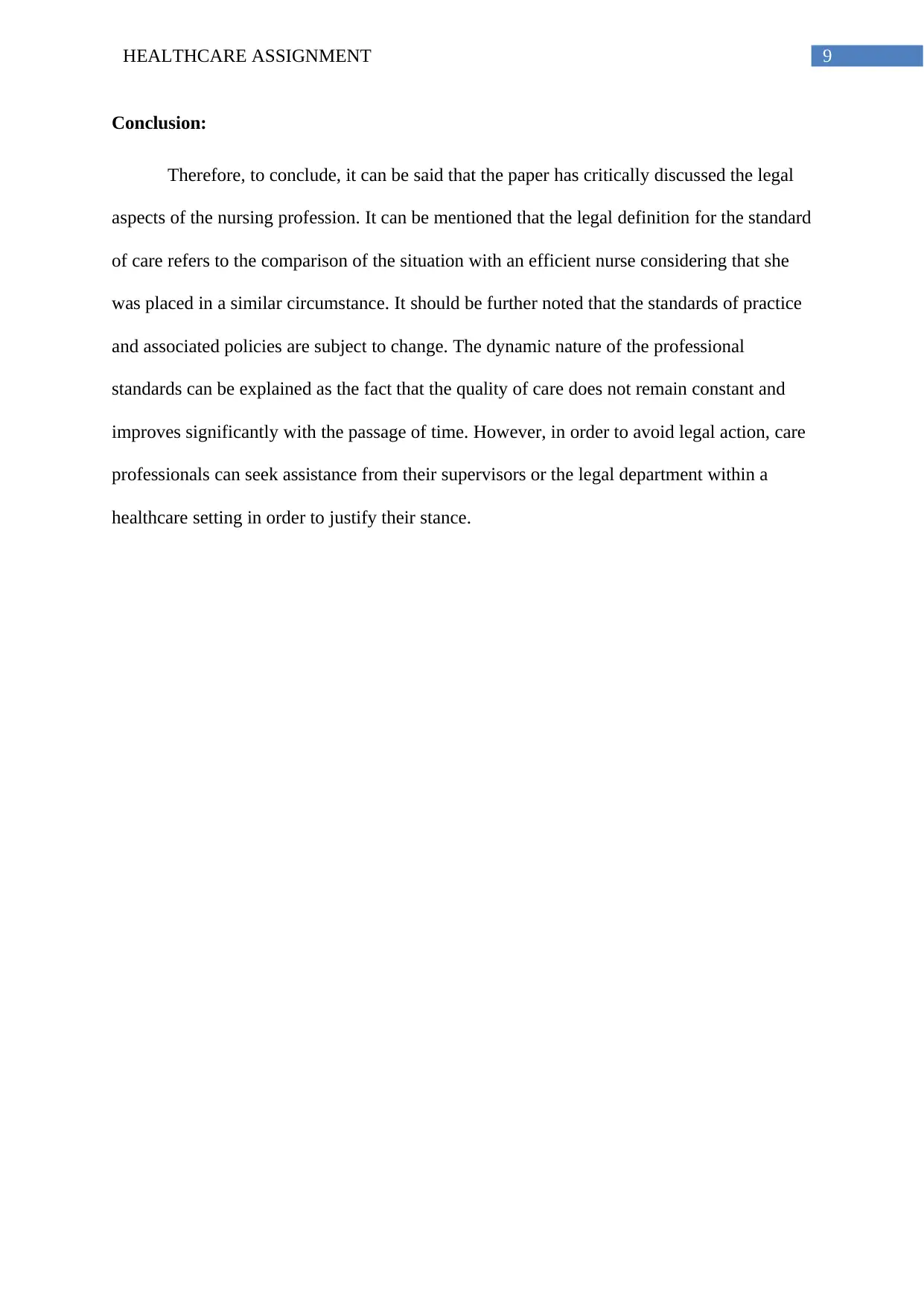
9HEALTHCARE ASSIGNMENT
Conclusion:
Therefore, to conclude, it can be said that the paper has critically discussed the legal
aspects of the nursing profession. It can be mentioned that the legal definition for the standard
of care refers to the comparison of the situation with an efficient nurse considering that she
was placed in a similar circumstance. It should be further noted that the standards of practice
and associated policies are subject to change. The dynamic nature of the professional
standards can be explained as the fact that the quality of care does not remain constant and
improves significantly with the passage of time. However, in order to avoid legal action, care
professionals can seek assistance from their supervisors or the legal department within a
healthcare setting in order to justify their stance.
Conclusion:
Therefore, to conclude, it can be said that the paper has critically discussed the legal
aspects of the nursing profession. It can be mentioned that the legal definition for the standard
of care refers to the comparison of the situation with an efficient nurse considering that she
was placed in a similar circumstance. It should be further noted that the standards of practice
and associated policies are subject to change. The dynamic nature of the professional
standards can be explained as the fact that the quality of care does not remain constant and
improves significantly with the passage of time. However, in order to avoid legal action, care
professionals can seek assistance from their supervisors or the legal department within a
healthcare setting in order to justify their stance.
Paraphrase This Document
Need a fresh take? Get an instant paraphrase of this document with our AI Paraphraser
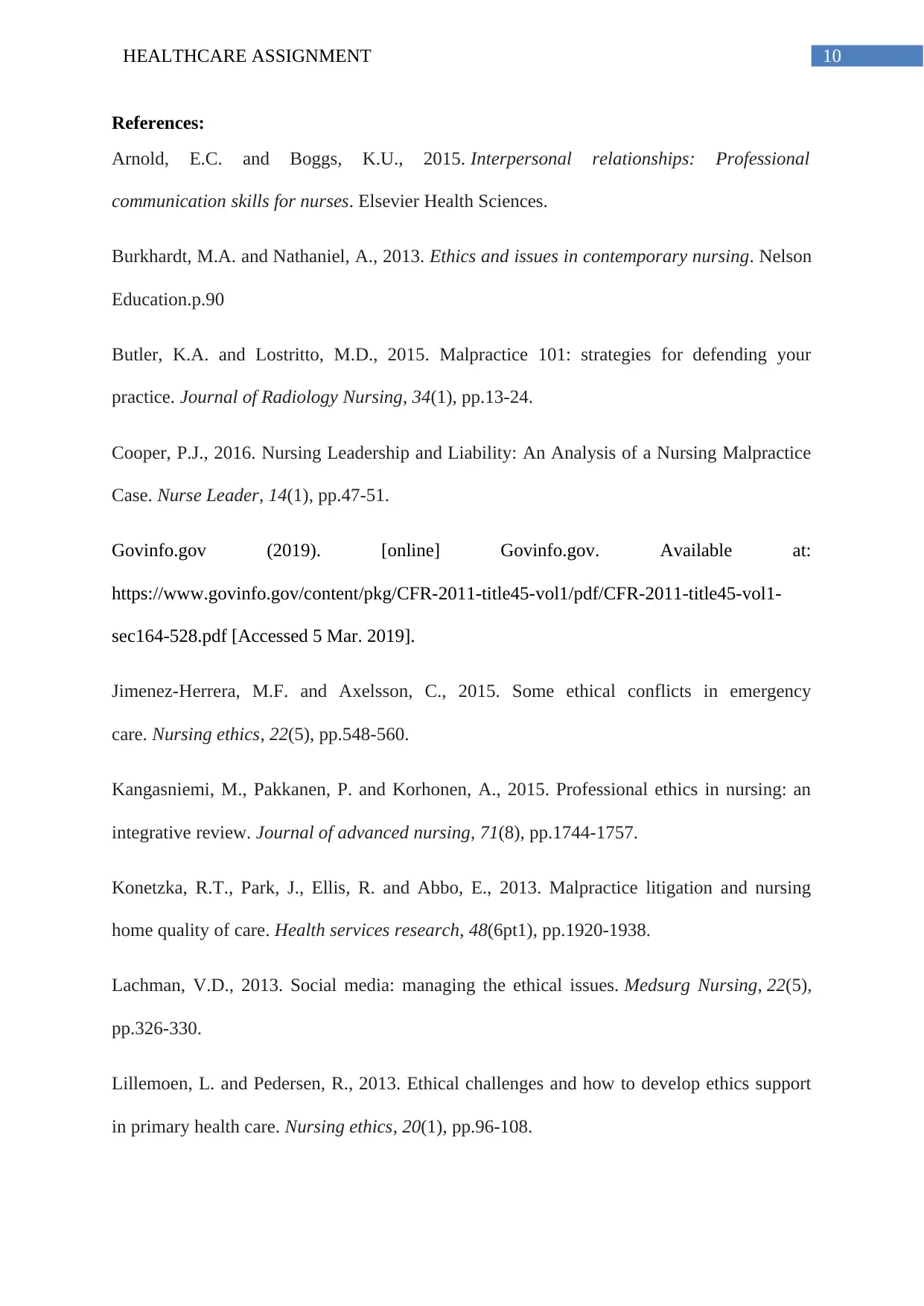
10HEALTHCARE ASSIGNMENT
References:
Arnold, E.C. and Boggs, K.U., 2015. Interpersonal relationships: Professional
communication skills for nurses. Elsevier Health Sciences.
Burkhardt, M.A. and Nathaniel, A., 2013. Ethics and issues in contemporary nursing. Nelson
Education.p.90
Butler, K.A. and Lostritto, M.D., 2015. Malpractice 101: strategies for defending your
practice. Journal of Radiology Nursing, 34(1), pp.13-24.
Cooper, P.J., 2016. Nursing Leadership and Liability: An Analysis of a Nursing Malpractice
Case. Nurse Leader, 14(1), pp.47-51.
Govinfo.gov (2019). [online] Govinfo.gov. Available at:
https://www.govinfo.gov/content/pkg/CFR-2011-title45-vol1/pdf/CFR-2011-title45-vol1-
sec164-528.pdf [Accessed 5 Mar. 2019].
Jimenez-Herrera, M.F. and Axelsson, C., 2015. Some ethical conflicts in emergency
care. Nursing ethics, 22(5), pp.548-560.
Kangasniemi, M., Pakkanen, P. and Korhonen, A., 2015. Professional ethics in nursing: an
integrative review. Journal of advanced nursing, 71(8), pp.1744-1757.
Konetzka, R.T., Park, J., Ellis, R. and Abbo, E., 2013. Malpractice litigation and nursing
home quality of care. Health services research, 48(6pt1), pp.1920-1938.
Lachman, V.D., 2013. Social media: managing the ethical issues. Medsurg Nursing, 22(5),
pp.326-330.
Lillemoen, L. and Pedersen, R., 2013. Ethical challenges and how to develop ethics support
in primary health care. Nursing ethics, 20(1), pp.96-108.
References:
Arnold, E.C. and Boggs, K.U., 2015. Interpersonal relationships: Professional
communication skills for nurses. Elsevier Health Sciences.
Burkhardt, M.A. and Nathaniel, A., 2013. Ethics and issues in contemporary nursing. Nelson
Education.p.90
Butler, K.A. and Lostritto, M.D., 2015. Malpractice 101: strategies for defending your
practice. Journal of Radiology Nursing, 34(1), pp.13-24.
Cooper, P.J., 2016. Nursing Leadership and Liability: An Analysis of a Nursing Malpractice
Case. Nurse Leader, 14(1), pp.47-51.
Govinfo.gov (2019). [online] Govinfo.gov. Available at:
https://www.govinfo.gov/content/pkg/CFR-2011-title45-vol1/pdf/CFR-2011-title45-vol1-
sec164-528.pdf [Accessed 5 Mar. 2019].
Jimenez-Herrera, M.F. and Axelsson, C., 2015. Some ethical conflicts in emergency
care. Nursing ethics, 22(5), pp.548-560.
Kangasniemi, M., Pakkanen, P. and Korhonen, A., 2015. Professional ethics in nursing: an
integrative review. Journal of advanced nursing, 71(8), pp.1744-1757.
Konetzka, R.T., Park, J., Ellis, R. and Abbo, E., 2013. Malpractice litigation and nursing
home quality of care. Health services research, 48(6pt1), pp.1920-1938.
Lachman, V.D., 2013. Social media: managing the ethical issues. Medsurg Nursing, 22(5),
pp.326-330.
Lillemoen, L. and Pedersen, R., 2013. Ethical challenges and how to develop ethics support
in primary health care. Nursing ethics, 20(1), pp.96-108.
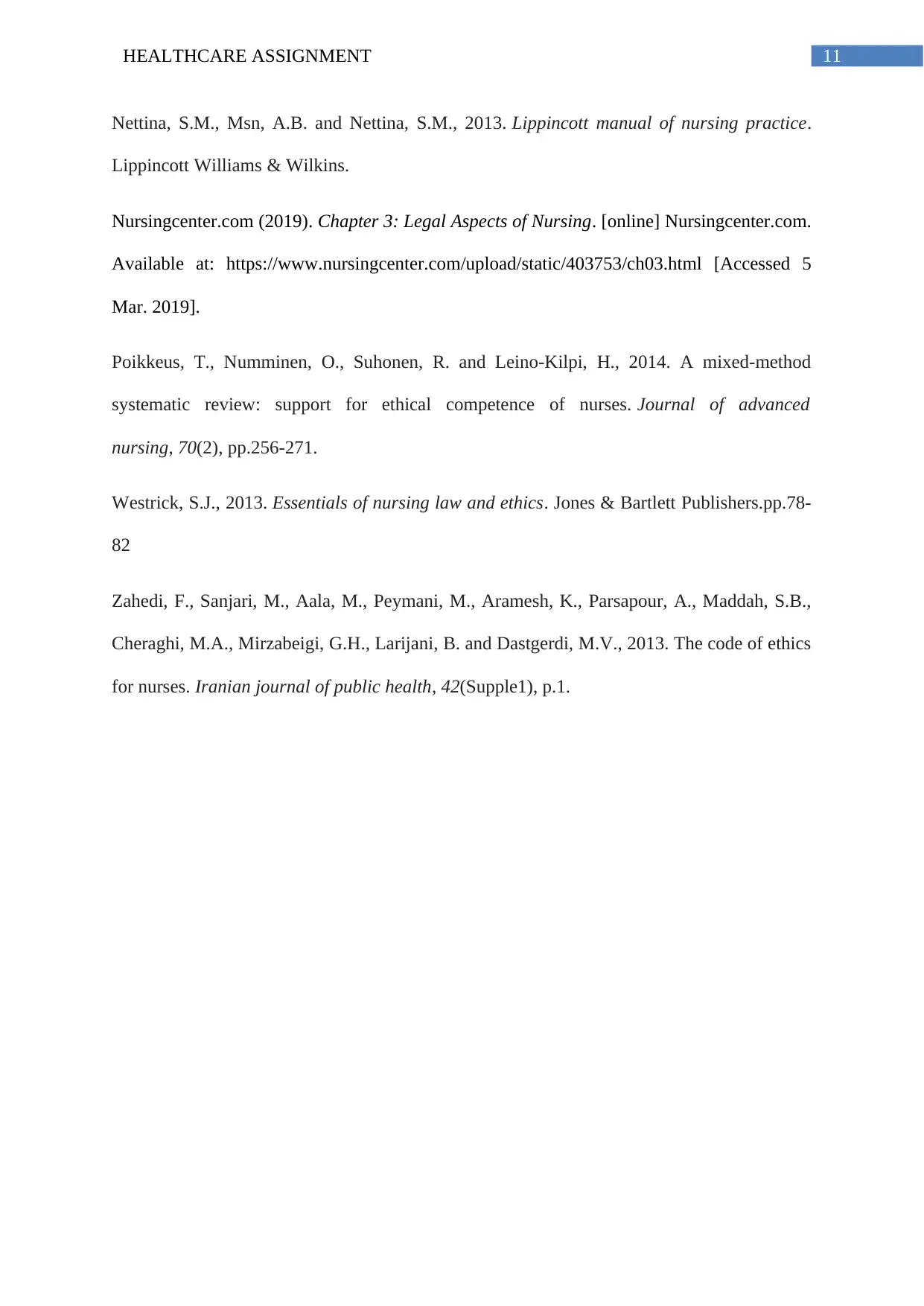
11HEALTHCARE ASSIGNMENT
Nettina, S.M., Msn, A.B. and Nettina, S.M., 2013. Lippincott manual of nursing practice.
Lippincott Williams & Wilkins.
Nursingcenter.com (2019). Chapter 3: Legal Aspects of Nursing. [online] Nursingcenter.com.
Available at: https://www.nursingcenter.com/upload/static/403753/ch03.html [Accessed 5
Mar. 2019].
Poikkeus, T., Numminen, O., Suhonen, R. and Leino‐Kilpi, H., 2014. A mixed‐method
systematic review: support for ethical competence of nurses. Journal of advanced
nursing, 70(2), pp.256-271.
Westrick, S.J., 2013. Essentials of nursing law and ethics. Jones & Bartlett Publishers.pp.78-
82
Zahedi, F., Sanjari, M., Aala, M., Peymani, M., Aramesh, K., Parsapour, A., Maddah, S.B.,
Cheraghi, M.A., Mirzabeigi, G.H., Larijani, B. and Dastgerdi, M.V., 2013. The code of ethics
for nurses. Iranian journal of public health, 42(Supple1), p.1.
Nettina, S.M., Msn, A.B. and Nettina, S.M., 2013. Lippincott manual of nursing practice.
Lippincott Williams & Wilkins.
Nursingcenter.com (2019). Chapter 3: Legal Aspects of Nursing. [online] Nursingcenter.com.
Available at: https://www.nursingcenter.com/upload/static/403753/ch03.html [Accessed 5
Mar. 2019].
Poikkeus, T., Numminen, O., Suhonen, R. and Leino‐Kilpi, H., 2014. A mixed‐method
systematic review: support for ethical competence of nurses. Journal of advanced
nursing, 70(2), pp.256-271.
Westrick, S.J., 2013. Essentials of nursing law and ethics. Jones & Bartlett Publishers.pp.78-
82
Zahedi, F., Sanjari, M., Aala, M., Peymani, M., Aramesh, K., Parsapour, A., Maddah, S.B.,
Cheraghi, M.A., Mirzabeigi, G.H., Larijani, B. and Dastgerdi, M.V., 2013. The code of ethics
for nurses. Iranian journal of public health, 42(Supple1), p.1.
⊘ This is a preview!⊘
Do you want full access?
Subscribe today to unlock all pages.

Trusted by 1+ million students worldwide
1 out of 12
Related Documents
Your All-in-One AI-Powered Toolkit for Academic Success.
+13062052269
info@desklib.com
Available 24*7 on WhatsApp / Email
![[object Object]](/_next/static/media/star-bottom.7253800d.svg)
Unlock your academic potential
Copyright © 2020–2025 A2Z Services. All Rights Reserved. Developed and managed by ZUCOL.





